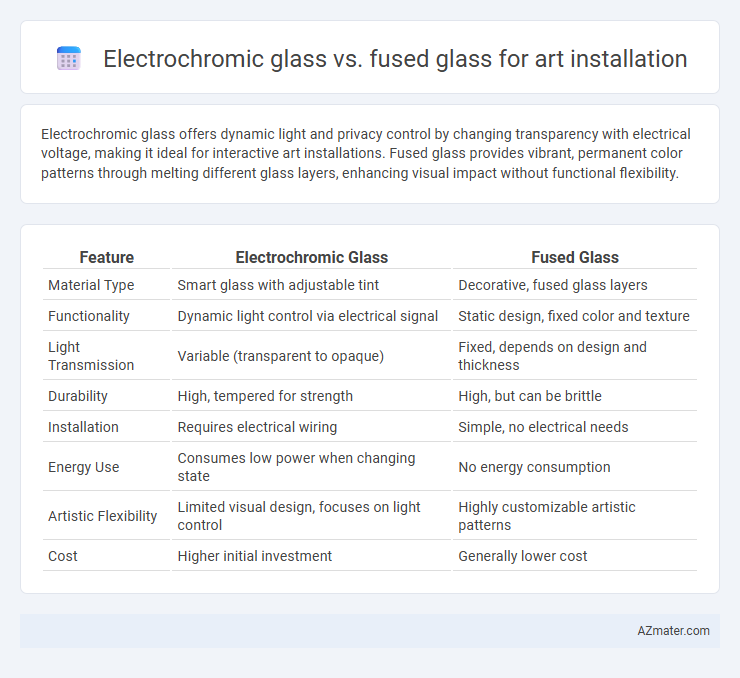Electrochromic glass offers dynamic light and privacy control by changing transparency with electrical voltage, making it ideal for interactive art installations. Fused glass provides vibrant, permanent color patterns through melting different glass layers, enhancing visual impact without functional flexibility.
Table of Comparison
| Feature | Electrochromic Glass | Fused Glass |
|---|---|---|
| Material Type | Smart glass with adjustable tint | Decorative, fused glass layers |
| Functionality | Dynamic light control via electrical signal | Static design, fixed color and texture |
| Light Transmission | Variable (transparent to opaque) | Fixed, depends on design and thickness |
| Durability | High, tempered for strength | High, but can be brittle |
| Installation | Requires electrical wiring | Simple, no electrical needs |
| Energy Use | Consumes low power when changing state | No energy consumption |
| Artistic Flexibility | Limited visual design, focuses on light control | Highly customizable artistic patterns |
| Cost | Higher initial investment | Generally lower cost |
Introduction to Electrochromic and Fused Glass in Art
Electrochromic glass offers dynamic light and privacy control by changing transparency with electrical voltage, enabling interactive and adaptive art installations. Fused glass involves layering and melting colored glass in a kiln to create intricate, textured visual effects, ideal for static, vibrant artistic expressions. Both materials provide unique opportunities for artists to manipulate light and form, enhancing the sensory experience of their work.
Core Features of Electrochromic Glass
Electrochromic glass offers dynamic light modulation by changing opacity through an electrical charge, providing precise control over transparency and solar heat gain, which enhances energy efficiency in art installations. Unlike fused glass, which is static and purely decorative, electrochromic glass integrates smart technology to protect sensitive artworks from UV damage while allowing customizable ambiance. Its core features include rapid switching between clear and tinted states, durability, and seamless integration with building automation systems for interactive displays.
Unique Qualities of Fused Glass
Fused glass offers unparalleled versatility in artistic expression through its ability to combine vibrant colors, varied textures, and intricate patterns within a single piece, making it a favored medium for art installations. Its unique qualities include precise control over thickness and form, allowing artists to create complex three-dimensional effects that cannot be achieved with Electrochromic glass. Unlike Electrochromic glass, which primarily serves functional purposes like dynamic tinting and energy efficiency, fused glass stands out for its exceptional aesthetic flexibility and tactile richness, enhancing visual impact in gallery or public art settings.
Aesthetic Possibilities for Art Installations
Electrochromic glass offers dynamic light modulation, allowing artists to control opacity and color intensity in real-time, creating interactive and evolving visual effects. Fused glass provides rich textural depth and vibrant color blending through kiln-fusing techniques, producing permanent, intricate designs with tactile qualities. Both materials enhance aesthetic versatility, with electrochromic glass emphasizing functionality and responsiveness, while fused glass emphasizes craftsmanship and vivid, static artistry.
Customization and Design Flexibility
Electrochromic glass offers dynamic tinting capabilities, enabling artists to control light transmission and color intensity in real-time, providing unparalleled customization for interactive installations. Fused glass, formed by melting layers of colored glass, allows intricate patterns, textures, and three-dimensional effects, appealing to tactile and visual design flexibility. Both materials support unique artistic expressions, with electrochromic glass excelling in adaptive environments and fused glass in detailed, handcrafted aesthetics.
Durability and Environmental Impact
Electrochromic glass offers dynamic light control through its smart tinting capabilities, enhancing energy efficiency and reducing carbon footprint in art installations while maintaining strong durability with scratch-resistant coatings. Fused glass, known for its permanent, kiln-fused designs, provides high physical durability and resilience to weathering but lacks the adaptability and energy-saving features of electrochromic technology. In terms of environmental impact, electrochromic glass contributes significantly to reducing energy consumption and heat gain, whereas fused glass's impact depends primarily on raw material sourcing and kiln energy use during production.
Interactive Potential: Lighting and Color Changes
Electrochromic glass offers dynamic control of lighting and color changes through its ability to switch transparency and tint in response to electrical stimuli, enabling real-time interaction in art installations. Fused glass, while rich in color and texture, remains static and lacks the capacity for on-demand alterations in appearance or luminosity. The interactive potential of electrochromic glass significantly enhances viewer engagement by integrating programmable light modulation directly into the artwork's physical medium.
Cost Comparison and Budget Considerations
Electrochromic glass typically incurs higher initial costs due to integrated smart technology that allows dynamic tinting, which can significantly impact art installation budgets. Fused glass, on the other hand, generally offers a more affordable option with lower production and material expenses, making it suitable for projects with strict budget constraints. Considering long-term value, electrochromic glass may reduce energy costs through light control, but fused glass remains cost-effective for static artistic designs without the need for technological features.
Installation Challenges and Maintenance Needs
Electrochromic glass requires specialized electrical wiring and control systems, making installation more complex than fused glass, which is simpler to mount but demands precise kiln work for proper fusing. Maintenance of electrochromic glass involves periodic calibration and electrical inspections to ensure uniform tinting, while fused glass primarily needs surface cleaning and inspection for physical cracks or chips. Both materials necessitate expert handling, but electrochromic glass installations typically incur higher upfront and ongoing costs due to technological components.
Choosing the Right Glass for Your Art Project
Electrochromic glass offers dynamic light control and energy efficiency by changing tint with electrical input, making it ideal for interactive or climate-sensitive art installations. Fused glass provides vibrant color blending and strong tactile presence through its kiln-fused layers, perfect for static, visually rich sculptures or panels. Selecting the right glass depends on whether the project prioritizes adaptive transparency and sustainability (electrochromic) or artistic texture and color depth (fused glass).

Infographic: Electrochromic glass vs Fused glass for Art installation
 azmater.com
azmater.com